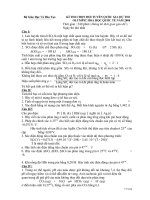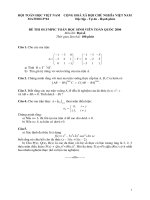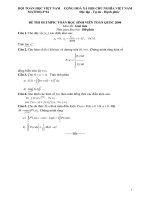Đề thi Olympic Toán học quốc tế BMO năm 2014
Bạn đang xem bản rút gọn của tài liệu. Xem và tải ngay bản đầy đủ của tài liệu tại đây (61.49 KB, 1 trang )
<span class='text_page_counter'>(1)</span><div class='page_container' data-page=1>
United Kingdom Mathematics Trust
British Mathematical Olympiad
Round 2 : Thursday, 30 January 2014
Time allowed Three and a half hours.
Each question is worth 10 marks.
Instructions <sub>•</sub> Full written solutions – not just answers – are
required, with complete proofs of any assertions
you may make. Marks awarded will depend on the
clarity of your mathematical presentation. Work
in rough first, and then draft your final version
carefully before writing up your best attempt.
Rough work should be handed in, but should be
clearly marked.
• One or two complete solutions will gain far more
credit than partial attempts at all four problems.
• The use of rulers and compasses is allowed, but
calculators and protractors are forbidden.
• Staple all the pages neatly together in the top left
hand corner, with questions 1, 2, 3, 4 in order, and
the cover sheet at the front.
• To accommodate candidates sitting in other time
zones, please do not discuss any aspect of the
paper on the internet until 8am GMT on Friday
31 January.
In early March, twenty students eligible to
rep-resent the UK at the International Mathematical
Olympiad will be invited to attend the training
session to be held at Trinity College, Cambridge
(3–7 April 2014). At the training session, students
sit a pair of IMO-style papers and eight students
will be selected for further training and selection
examinations. The UK Team of six for this
summer’s IMO (to be held in Cape Town, South
Africa, 3–13 July 2014) will then be chosen.
Do not turn over untiltold to do so.
United Kingdom Mathematics Trust
2013/14 British Mathematical Olympiad
Round 2
1. Every diagonal of a regular polygon with 2014 sides is coloured in one
of n colours. Whenever two diagonals cross in the interior, they are
of different colours. What is the minimum value ofnfor which this is
possible?
2. Prove that it is impossible to have a cuboid for which the volume, the
surface area and the perimeter are numerically equal. The perimeter
of a cuboid is the sum of the lengths of all its twelve edges.
3. Let a0 = 4 and define a sequence of terms using the formula an =
a2
n<sub>−</sub>1−an<sub>−</sub>1 for each positive integern.
a) Prove that there are infinitely many prime numbers which are
factors of at least one term in the sequence;
b) Are there infinitely many prime numbers which are factors of no
term in the sequence?
4. Let ABC be a triangle and P be a point in its interior. Let AP
meet the circumcircle of ABC again at A′<sub>.</sub> <sub>The points</sub> <sub>B</sub>′ <sub>and</sub>
C′ <sub>are similarly defined.</sub> <sub>Let</sub> <sub>O</sub>
A be the circumcentre of BCP.
The circumcentres OB and OC are similarly defined. Let OA′ be
the circumcentre of B′<sub>C</sub>′<sub>P</sub><sub>.</sub> <sub>The circumcentres</sub> <sub>O</sub><sub>B</sub>′ <sub>and</sub> <sub>O</sub>
</div>
<!--links-->









